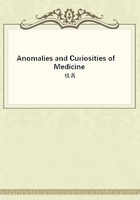
第82章
Goodell speaks of Minna and Minnie Finley, who were born in Ohio and examined by him. They were fused together in a common longitudinal axis, having one pelvis, two heads, four legs, and four arms. One was weak and puny and the other robust and active;it is probable that they had but one rectum and one bladder.
Goodell accompanies his description by the mention of several analogous cases. Ellis speaks of female twins, born in Millville, Tenn., and exhibited in New York in 1868, who were joined at the pelves in a longitudinal axis. Between the limbs on either side were to be seen well-developed female genitals, and the sisters had been known to urinate from both sides, beginning and ending at the same time.
Huff details a description of the "Jones twins," born on June 24, 1889, in Tipton County, Indiana, whose spinal columns were in apposition at the lower end. The labor, of less than two hours'
duration, was completed before the arrival of the physician.
Lying on their mother's back, they could both nurse at the same time. Both sets of genitals and ani were on the same side of the line of union, but occupied normal positions with reference to the legs on either side. Their weight at birth was 12 pounds and their length 22 inches. Their mother was a medium-sized brunette of 19, and had one previous child then living at the age of two;their father was a finely formed man 5 feet 10 inches in height.
The twins differed in complexion and color of the eyes and hair.
They were publicly exhibited for some time, and died February 19and 20, 1891, at St. John's Hotel, Buffalo, N.Y. Figure 45 shows their appearance several months after birth.
CLASS VI.--In our sixth class, the first record we have is from the Commentaries of Sigbert, which contains a description of a monstrosity born in the reign of the Emperor Theodosius, who had two heads, two chests with four arms attached, but a single lower extremity. The emotions, affections, and appetites were different. One head might be crying while the other laughed, or one feeding while the other was sleeping. At times they quarreled and occasionally came to blows. This monster is said to have lived two years, one part dying four days before the other, which evinced symptoms of decay like its inseparable neighbor.
Roger of Wendover says that in Lesser Brittany and Normandy, in 1062, there was seen a female monster, consisting of two women joined about the umbilicus and fused into a single lower extremity. They took their food by two mouths but expelled it at a single orifice. At one time, one of the women laughed, feasted, and talked, while the other wept, fasted, and kept a religious silence. The account relates how one of them died, and the survivor bore her dead sister about for three years before she was overcome by the oppression and stench of the cadaver. Batemen describes the birth of a boy in 1529, who had two heads, four ears, four arms, but only two thighs and two legs. Buchanan speaks at length of the famous "Scottish Brothers," who were the cynosure of the eyes of the Court of James III of Scotland. This monster consisted of two men, ordinary in appearance in the superior extremities, whose trunks fused into a single lower extremity. The King took diligent care of their education, and they became proficient in music, languages, and other court accomplishments. Between them they would carry on animated conversations, sometimes merging into curious debates, followed by blows. Above the point of union they had no synchronous sensations, while below, sensation was common to both. This monster lived twenty-eight years, surviving the royal patron, who died June, 1488. One of the brothers died some days before the other, and the survivor, after carrying about his dead brother, succumbed to "infection from putrescence." There was reported to have been born in Switzerland a double headed male monster, who in 1538, at the age of thirty, was possessed of a beard on each face, the two bodies fused at the umbilicus into a single lower extremity. These two twins resembled one another in contour and countenance. They were so joined that at rest they looked upon one another. They had a single wife, with whom they were said to have lived in harmony. In the Gentleman's Magazine about one hundred and fifty years since there was given the portrait and description of a double woman, who was exhibited all over the large cities of Europe. Little can be ascertained anatomically of her construction, with the exception that it was stated that she had two heads, two necks, four arms, two legs, one pelvis, and one set of pelvic organs.
The most celebrated monster of this type was Ritta-Christina, who was born in Sassari, in Sardinia, March 23, 1829. These twins were the result of the ninth confinement of their mother, a woman of thirty-two. Their superior extremities were double, but they joined in a common trunk at a point a little below the mammae.